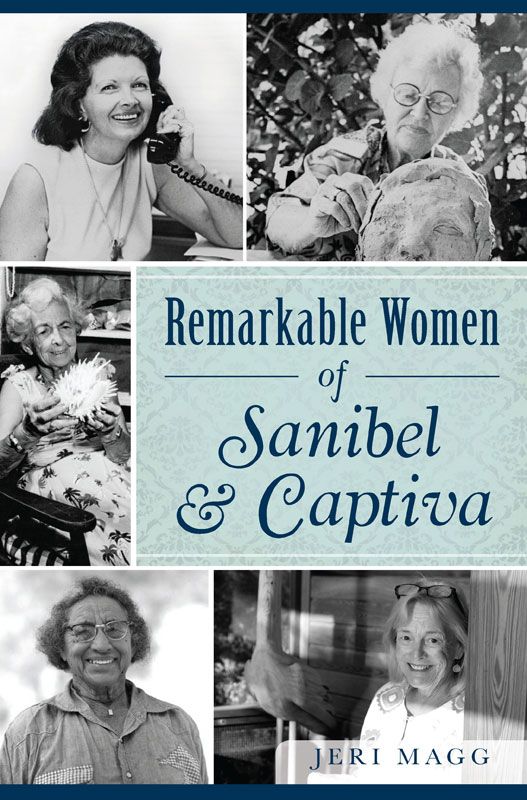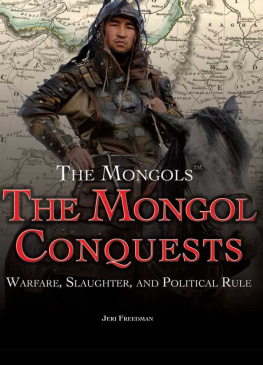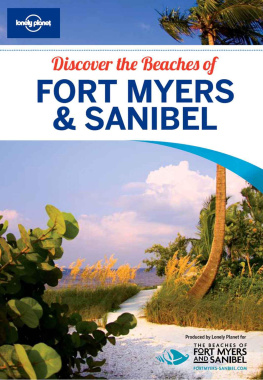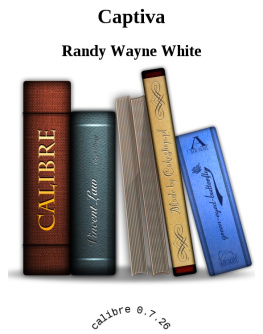Jeri Magg - Remarkable Women of Sanibel & Captiva
Here you can read online Jeri Magg - Remarkable Women of Sanibel & Captiva full text of the book (entire story) in english for free. Download pdf and epub, get meaning, cover and reviews about this ebook. year: 2016, publisher: Arcadia Publishing, genre: Non-fiction. Description of the work, (preface) as well as reviews are available. Best literature library LitArk.com created for fans of good reading and offers a wide selection of genres:
Romance novel
Science fiction
Adventure
Detective
Science
History
Home and family
Prose
Art
Politics
Computer
Non-fiction
Religion
Business
Children
Humor
Choose a favorite category and find really read worthwhile books. Enjoy immersion in the world of imagination, feel the emotions of the characters or learn something new for yourself, make an fascinating discovery.

- Book:Remarkable Women of Sanibel & Captiva
- Author:
- Publisher:Arcadia Publishing
- Genre:
- Year:2016
- Rating:4 / 5
- Favourites:Add to favourites
- Your mark:
- 80
- 1
- 2
- 3
- 4
- 5
Remarkable Women of Sanibel & Captiva: summary, description and annotation
We offer to read an annotation, description, summary or preface (depends on what the author of the book "Remarkable Women of Sanibel & Captiva" wrote himself). If you haven't found the necessary information about the book — write in the comments, we will try to find it.
Remarkable Women of Sanibel & Captiva — read online for free the complete book (whole text) full work
Below is the text of the book, divided by pages. System saving the place of the last page read, allows you to conveniently read the book "Remarkable Women of Sanibel & Captiva" online for free, without having to search again every time where you left off. Put a bookmark, and you can go to the page where you finished reading at any time.
Font size:
Interval:
Bookmark:



Published by The History Press
Charleston, SC
www.historypress.net
Copyright 2016 by Jeri Magg
All rights reserved
First published 2016
e-book edition 2016
ISBN 978.1.62585.537.4
Library of Congress Control Number: 2015943177
print edition ISBN 978.1.46711.766.1
Notice : The information in this book is true and complete to the best of our knowledge. It is offered without guarantee on the part of the author or The History Press. The author and The History Press disclaim all liability in connection with the use of this book.
All rights reserved. No part of this book may be reproduced or transmitted in any form whatsoever without prior written permission from the publisher except in the case of brief quotations embodied in critical articles and reviews.
Contents
Acknowledgements
As any author knows, without the help of others, editors, researchers, librarians and other historians, my book would not have been completed. Betty Anholt, Ann Bradley and Deb Gleason knew the facts and were ready to share them.
My docent friends at the Sanibel Historical Museum and Village offered encouragement. Special thanks to Martha Jeffers, who trudged through the manuscript, sometimes bleary-eyed, to edit the mistakes. My gratitude also goes to Emilie Alfino, manager of the Sanibel Historical Museum and Village, who waded through the manuscript checking all the facts. These words of thanks would not be complete without a posthumous tribute to Manfred Strobel, my photographer for my first book. Many of the photos in this book are also his. I am sorry that he did not have a chance to read my second book, too.
And lastly, special gratitude and love go to my husband, Karl, who supports my efforts in all causes, even when he spends more than six months as second banana to my manuscript.
Introduction
The Calusa Women
Throughout the ages, women have been the subject of love poems or the muses for artists or even the causes of wars. However, more times than not, their influence has had a stabilizing effect that calmed the chaos and eventually ensured that a civilization endured. There are exceptions, but it is fair to say that were it not for women, man would have run amok long ago. This analogy can be made in part when discussing the strong female influence on the histories of Sanibel and Captiva Islands.
Historians believe the Calusa are the first inhabitants, arriving around AD 500. Controlling the west coast of Florida south of Tampa Bay, these natives were attracted by oyster bars, fish, turtle and other food sources. Before long, Calusa were settling in the oldest part of Sanibel near the exit from J.N. Ding Darling National Wildlife Refuge. Archaeologists have found Indian artifacts in this area dating back 2,300 years.
Present-day Sanibel, Captiva, Pine Island, Fort Myers and Estero were the heart of the Calusa territory. The capital was said to be Mound Key, then known as Calos, on the east side of Estero Bay. At the height of their culture, almost twenty thousand natives inhabited the area. They didnt farm, preferring to hunt and fish. The men were excellent sailors and fierce fighters. They didnt scalp their enemies but beheaded them instead, which made a bigger statement.
Caloosahatchee means river of the Calusa, which served as the main highway inland for the Calusa Indians. They canoed down the river into Lake Okeechobee to access other tribal areas by way of the Kissimmee River.

Sanibel lighthouse and cottages. Photo by Manfred Strobel .
What we do know about the Calusa comes from a study of the shell mounds of some of the forty villages that spread south along the Gulf coast, such as the 240-acre site at Pineland, the Calusa capital.
Historical accounts tell of the Spanish arrival in San Carlos Bay in the early 1500s. Eager to acquire land, gold and slaves for the crown, they captured Calusa women as prizes. Ponce de Len wanted to impress the king and queen with his success in conquering the natives, characterizing them as easy to tame. Though able to sell this false tale to gain more funds for a return voyage, he and other explorers would pay dearly for not realizing the ferocity of these native warriors.
JUAN PONCE DE LEN MEETS THE CALUSA INDIANS
While Juan Ponce de Len was searching for Bimini, where he believed the fabled fountain of youth was located, he discovered Florida. He sailed north along its coast for several days until he realized that what he had actually found was not an island but an unknown mainland. Several days later, he landed near what is present-day St. Augustine.

A Calusa Indian mask. Courtesy Sanibel Historical Museum and Village .
He went ashore and claimed the land for the king of Spain, naming it Pascua Florida (Feast of Flowers) since he found it during the Easter season. Continuing his journey south, he rounded the Florida Keys and hugged the coastline northward.
Once parallel with Captiva, he entered Pine Island Sound and dropped anchor off the west coast of Pine Island. There, his crew spent ten days cleaning the hull of his ship, gathering firewood and filling their water barrels. As they were pulling up anchor, the Indians attacked. The sailors became so angry they chased the Indians to shore and captured four women. This action subdued the Calusa for a while, but it would take the Spanish almost fifty years before they realized the Indians would never be conquered.
Ponce de Len spent twenty-one days in the bay area before understanding that he would not find the fountain of youth. He then ordered his ships to pull up anchor and sailed southeast to Puerto Rico.
In 1521, Ponce de Len returned to the area with two hundred settlers, cattle and building materials. The Calusa, remembering his earlier voyage, watched in the shadows. This time, they allowed the Spaniards to rest before sneaking up on them at night and attacking. Eighty Spanish sailors died, and Ponce de Len was severely wounded by an arrow in the thigh. Though most of the attacking Indians were also killed, they still managed to demoralize the Spaniards, who weighed anchor and limped back to Cuba. Ponce de Len died there after his wound became infected.
PEDRO MENNDEZ DE VILES COMES IN PEACE
By 1566, when Pedro Menndez de viles sailed into the bay near the island of Sanibel, the ferocious nature of the Calusa was legend.
While on board, one of his crew noticed a lone figure in a dugout canoe approaching the ship. Though dressed as an Indian, the man spoke Spanish. Once aboard, the man showed his cross and told tales about his capture and life among the Calusa. Upon hearing the story, Menndez fell to his knees and gave thanks to God for helping him accomplish one of his objectives: to rescue the Christian captives of the Calusa.
Menndezs last two objectivesto convert the Indians to Christianity and reclaim land held by other European countries for Spainwere still to be fulfilled. His rewards were the titles of governor and captain general of Florida.
Font size:
Interval:
Bookmark:
Similar books «Remarkable Women of Sanibel & Captiva»
Look at similar books to Remarkable Women of Sanibel & Captiva. We have selected literature similar in name and meaning in the hope of providing readers with more options to find new, interesting, not yet read works.
Discussion, reviews of the book Remarkable Women of Sanibel & Captiva and just readers' own opinions. Leave your comments, write what you think about the work, its meaning or the main characters. Specify what exactly you liked and what you didn't like, and why you think so.








